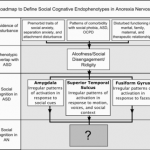Mental health articles
OF mental health care and mentally ill
Childhood onset anorexia nervosa
Childhood onset anorexia nervosa
The co-ordinal features of childhood onset anorexia nervosa are: •failure to maintain weight gain or actual weight loss in relation to age; •determined food avoidance; •abnormal concerns/preoccupation with weight and shape; and •amenorrhoea in post-menarcheal adolescents or delayed or arrested puberty.
Incidence and prevalence
In adolescent populations the prevalence of anorexia is estimated to be 0.1 to 0.2 per cent, and is lower in younger children. Most clinics report an increase in the number of referrals to specialist services and there is some evidence of an increase in incidence. Among adolescents, 5–10 per cent of cases occur in males while in younger male children the numbers may be up to a third. The aetiology of eating disorders is complex and needs to be viewed from a bio-psychosocial perspective. A number of biological factors may play a part, including endocrine dysfunction affecting the hypothalmic pituitary gonadal axis and genetic factors although its exact effects remain uncertain.
Although a number of psychological and familial factors have been implicated as playing a role in the pathogenesis of anorexia nervosa, there is insufficient empirical evaluation for these hypotheses. Cultural and social factors are also important. Earlier studies suggested a preponderance of higher social class, although this is not marked in adolescence. Generally, eating disorders are reported more frequently in societies where food is plentiful and thinness is valued. The risk of anorexia is high in occupations such as modelling and ballet dancing where there is an emphasis on slimness.
Post Footer automatically generated by wp-posturl plugin for wordpress.
More from my site
Tags: anorexia nervosa, Childhood







Leave a Reply